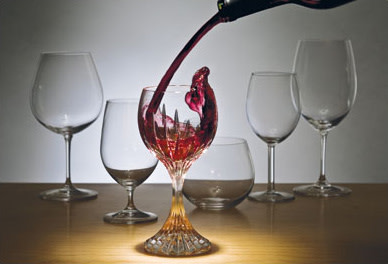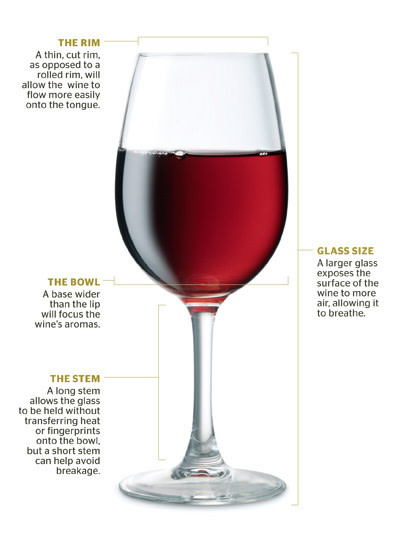Glitter and Glass

Pull the cork out of a bottle of wine and listen: That satisfying sound marks the beginning of what could well be the best part of the day—all you need is a couple of glasses. From a humble tumbler to a rarefied crystal chalice, there are almost as many wine glasses on the market as there are varieties of wine. But is the choice of glassware an essential step in proper wine enjoyment or just another snooty obsession?
The Austrian company Riedel pioneered the design of stemware for particular wine varieties in 1961, and since then has engaged (along with many other companies) in unbridled shape proliferation. But would a relative wine novice be able to tell the difference?
As a mostly self-educated wine lover of modest means, I’m willing to spend a little cash to deepen my appreciation of the occasional splurge on a $20 pinot. But to spend a ton of money to fine-tune my slurp of every varietal, I need proof. So I sought out some professionals.
{page break}
Shaping Flavor
Timothy Nishimoto, co-owner of Vino Paradiso in the Pearl, has attended two tasting seminars run by Riedel, and he graciously lined up some glasses to compare. Up to 80 percent of what we call “taste” is actually smell, and while we can distinguish just five general tastes (sweet, salty, bitter, sour and umami, meaning meaty or savory), our noses are more sensitive, allowing us to discriminate among thousands of compounds. When Nishimoto pours a 2005 Raptor Ridge pinot noir into a glass designed for the wine, the wide, tapering bowl emphasizes the aroma. “You don’t have to get your nose right in there,” he points out. “You’re enjoying it before you’re drinking it.”
The aroma of the same wine served in a smaller, less-tapered glass is harder to appreciate because the wine has less surface area in contact with the air, and the aromas are not as well concentrated by the glass’s wider opening. A tall, straight chimney glass hides the wine’s bouquet even more, and after the thin stemware, the thick rolled rim seems clumsy on the lips.
Up to 80 percent of what we call “taste” is actually smell. Our noses are sensitive, allowing us to discern thousands of compounds.
But does this mean you should go out and get a different glass for every wine variety? “I think that’s silly,” says Heathman Hotel sommelier Jeff Groh. “We have burgundy and Bordeaux glasses, and that’s good enough to get us through 700 different wines.”
Mimi Martin, of the Wine and Spirit Archive in Southeast Portland, acknowledges the popularity of varietal stemware shapes, but says that using one glass for all varieties of wine facilitates the comparison of one wine to another. “What is most important for tasting is that the glass have a large-enough bowl to allow you to swirl the wine; that the lip of the glass is narrow; and that the glass is tulip-shaped—the lip narrower than the base—to focus the aromas,” Martin says. Ken Collura, of the Pearl District’s Andina restaurant and the Pearl Wine Shop, adds that a short stem is good for avoiding breakage.
Traditionalists, however, favor a long stem, which allows the glass to be held without transferring body heat to the wine and unsightly fingerprints to the bowl.
{page break}
What Can I Get For the Money?
Despite what your tongue, nose and eyes tell you, your wallet still speaks the loudest. If you need a lot of glasses, don’t have much money to spend or are accident-prone, head to a restaurant supply outlet. At Pitman Restaurant Supply in inner Southeast, Rose’s Equipment & Supply around the corner or Boxer Northwest in Old Town, cases of inexpensive stemware are stacked among Fryolators and refrigerators. Most of these glasses are made by Libbey, the first company to produce machine-made stemware and feature a rolled rim rather than the thin, cut rim that Martin and other wine connoisseurs favor. Still, at just a few dollars each—and with discounts for multiple-case purchases—this could be the way to go for your extended family reunion or block party. Periodically, you can also find deals online and get higher-end glasses for next to nothing. Groh found the Spiegelau glasses he uses at home for $3 each, on sale at Amazon.com.
For something a little more elegant, head to Liner & Elsen in Northwest Portland, which stocks Riedel’s dizzying array of glasses. The Vinum series is a good midrange line and goes for about $15 to $20 per stem. If, on the other hand, you want glasses that pair well with your European Masters collection, drop your pocket change on the fine crystal at Zell Brothers Jewelers downtown. Products from European crystal makers like Saint Louis (who King Louis XV honored with the title “Royal Glassworks” in 1767) stand alongside other glasses from modern designers like Vera Wang. While some go for as little as $150 a stem, the top end ($1,140 each for some of the Saint Louis) is high enough that you’ll have to satisfy your own curiosity about how wine tastes in them.
If off-the-shelf just won’t do, or you want a unique gift, two Portland artisan companies, Elements Glass and Vitreluxe, create custom, hand-blown stemware. Lynn Read of Vitreluxe uses remelted post-manufacturing colored glass, so you can go green even before recycling the wine bottle. Prices start at $180 per glass.
{page break}
Choose for the Occasion
Ultimately, the choice of glass might have less to do with the wine than the setting and the company. A small bistro glass is a friendly way to share a bottle with friends around the picnic table in your yard, when bringing out your Saint Louis might be too much like showing up to a barbecue in a tuxedo. However, if you want the reflections of flickering candles and the gently wafting aromas of a good Oregon pinot to be part of the moment’s memory, delicate stemware will encourage a slow, luxurious evening—just like you planned.
Anatomy of a Wine Glass
There are several physical characteristics of a glass that bring out the flavor and aroma of a wine. Look for a wider bowl, a narrow lip and quality, thin glass. Here are a few things to remember when shopping.

{page break}
Critic’s Choice
Let’s face it. There are only so many glasses you’re going to purchase. So we asked Jeff Groh (of the Heathman Hotel) to define his four must-haves for a functional wine collection. Here’s what he recommends:

A. A great everyday glass that’s light enough in the hand to feel chic but affordable enough to break without too many tears. Use with cabernets, merlots, white and red Bordeaux, Chianti and zinfandel. ($42 per set of six at Amazon.com)
B. They may not be the top-of-the-line Sommelier series, which are as expensive as they are thin, but these are still glasses worth crying over. Light and delicate in the hand, much like the wines they are meant for. ($15 per stem at Liner & Elsen)
C. This glass won me over with its versatility. Its shape and size will complement ports, sauternes, sherry, Armagnac, Cognac and more. (Liner & Elsen can order a set of six for around $100)
D. Similar to the Bordeaux, but with a wider bowl, allowing the wine to have more surface area in contact with the air. Use with pinot noir, syrah, chardonnay and nebbiolos. ($55 per set of six at Amazon.com)
